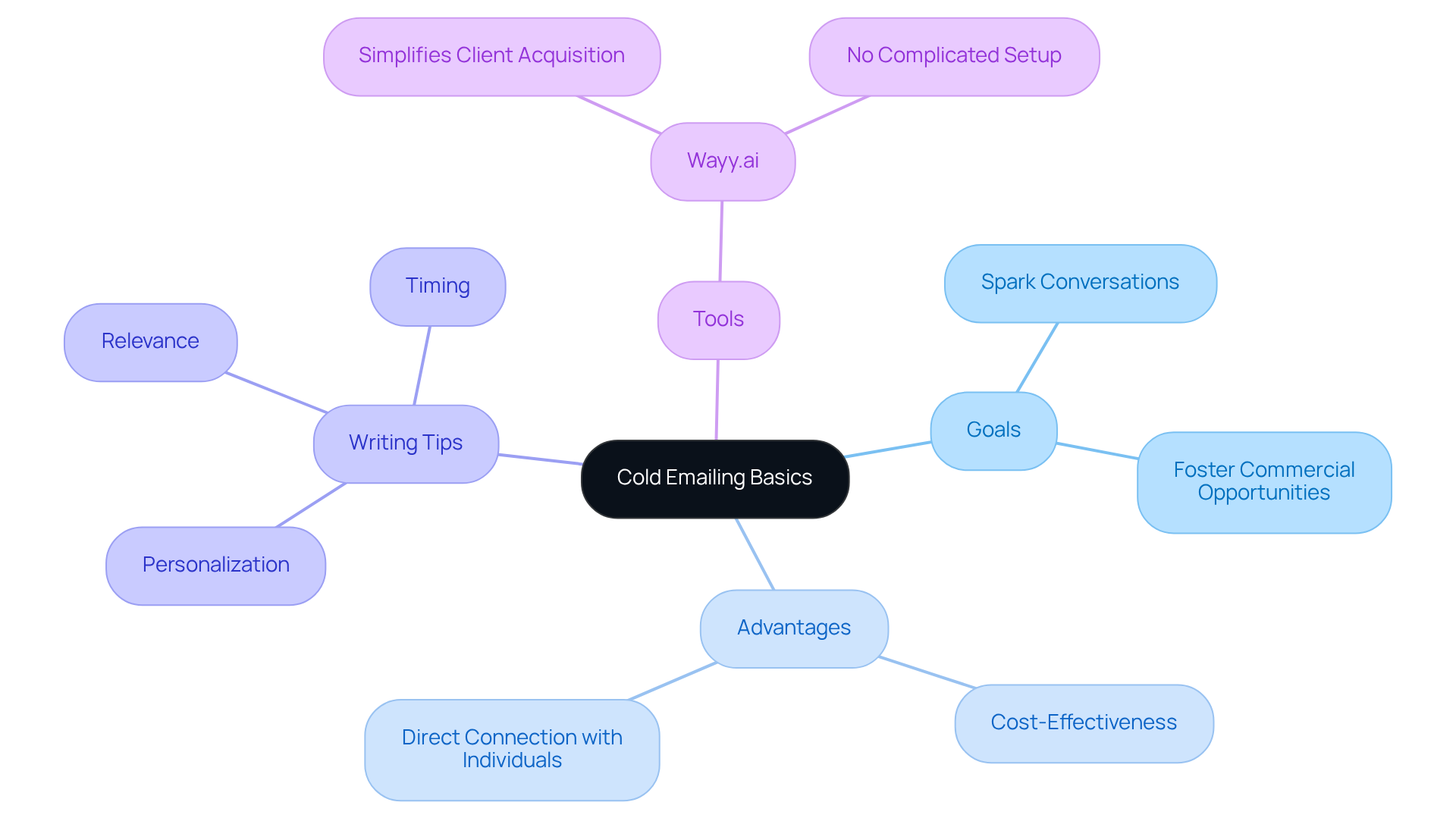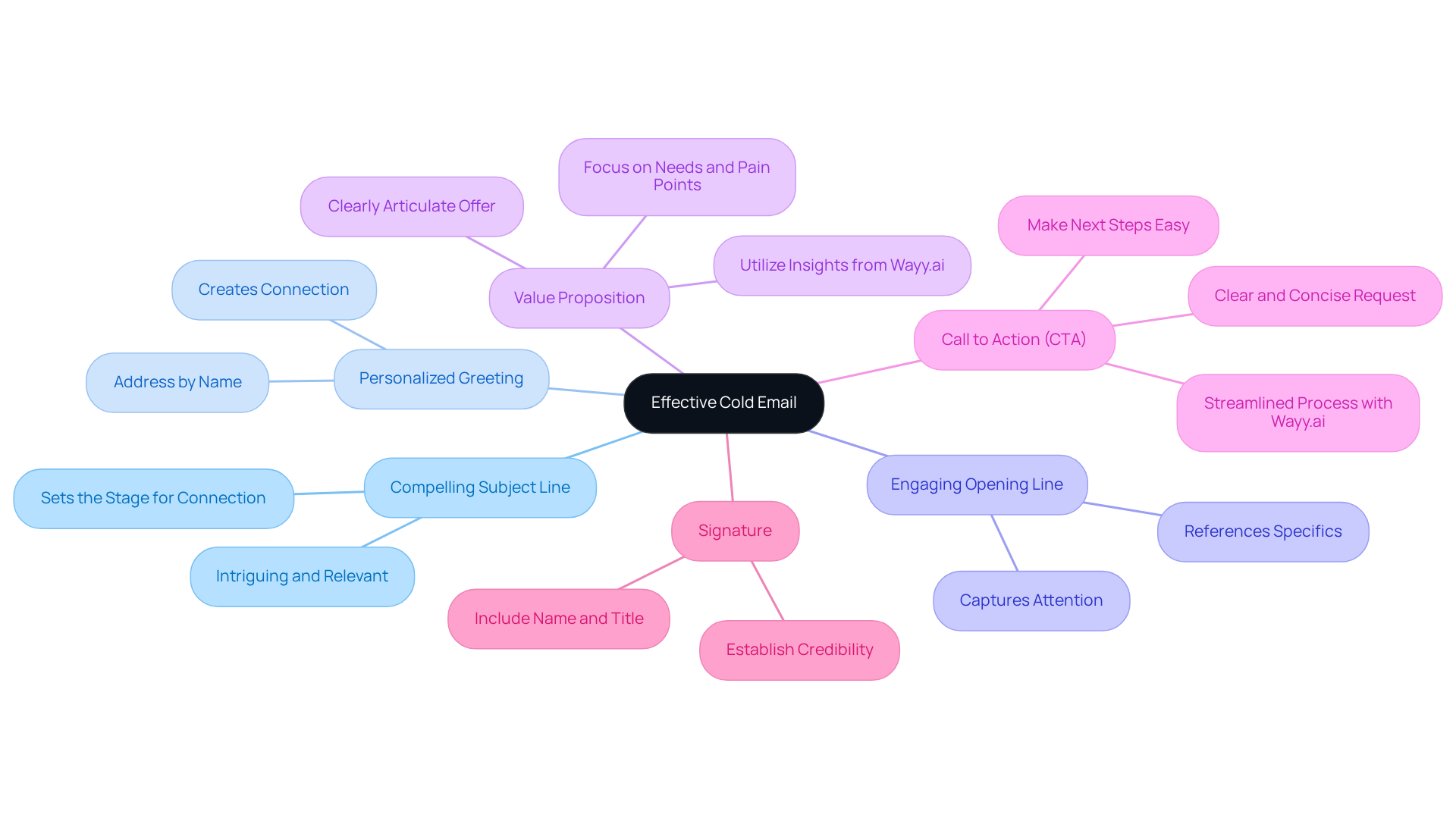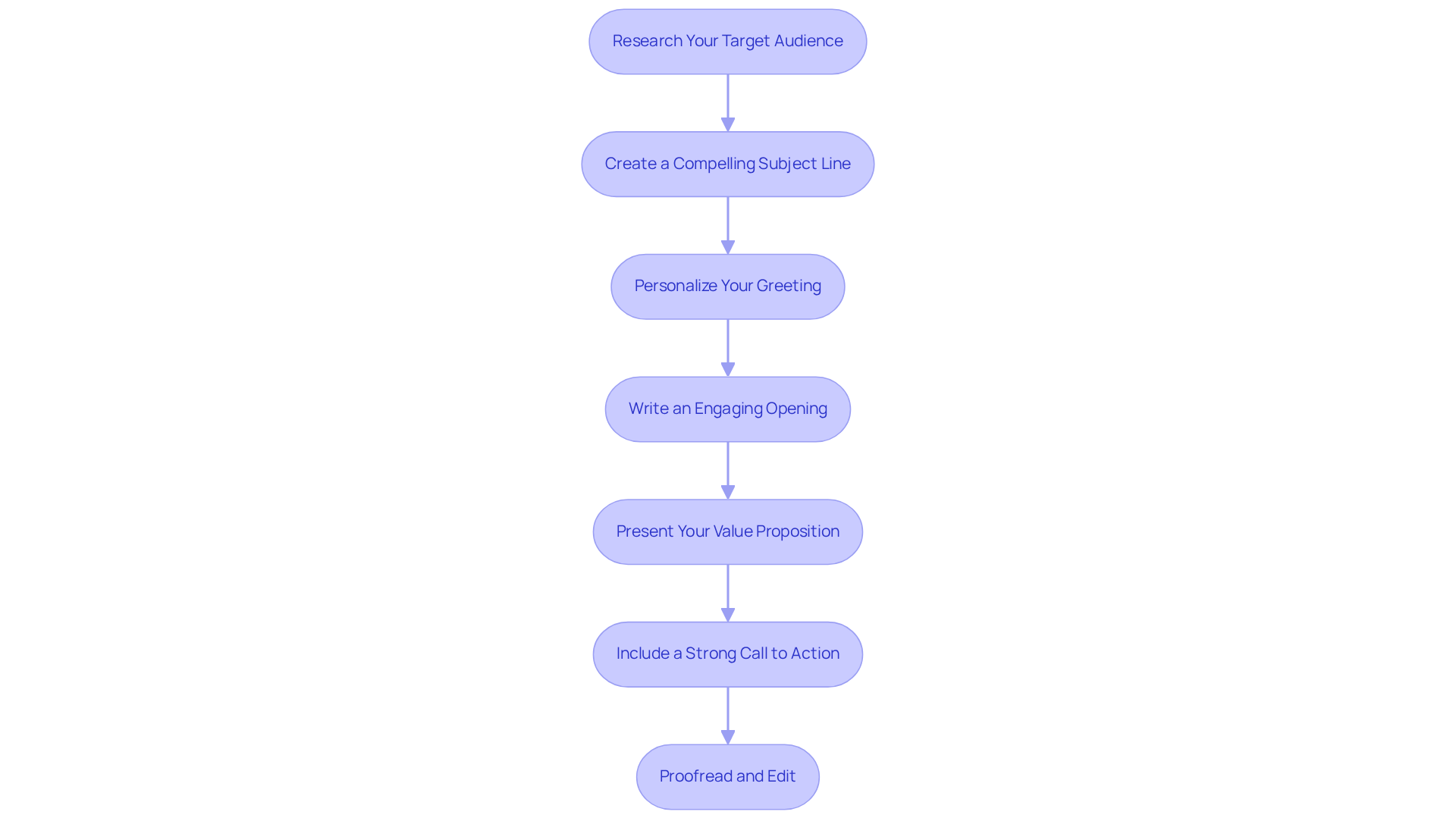Overview
This article offers a step-by-step guide designed to help small businesses craft effective cold emails. We understand that reaching out to potential clients can be daunting, which is why personalization, clarity, and a strong call to action are emphasized throughout. By focusing on these elements, we aim to ease your concerns and provide you with a clear path forward.
Key components of a successful cold email include a compelling subject line and a value proposition that speaks directly to your audience's needs. Imagine your email standing out in a crowded inbox, capturing attention, and inviting engagement. To further support your efforts, we also share practical follow-up techniques that can significantly enhance your engagement and response rates.
Together, we can navigate the challenges of cold emailing, transforming it into an opportunity for connection and growth. By implementing these strategies, you can foster meaningful relationships that lead to success for your business.
Introduction
Crafting a successful cold email can truly be the game-changer that small businesses need to expand their client base and forge valuable connections. In this guide, we will delve into the essential elements of cold emailing, offering a step-by-step approach that demystifies the process and empowers you as an entrepreneur to engage potential clients effectively. Yet, with so many businesses vying for attention in crowded inboxes, how can you stand out and ensure your message resonates? Together, we can explore these challenges and find solutions that work for you.
Understand Cold Emailing Basics
Cold emailing is more than just sending unsolicited messages; it's an opportunity to reach out to potential clients or contacts with whom you may not yet have a relationship. The primary goal here is to spark a conversation that could lead to a fruitful commercial opportunity, such as a sale or partnership. Unlike traditional marketing methods, cold emailing allows you to connect directly with specific individuals, making it a cost-effective strategy for small businesses looking to grow.
Imagine having a tool that simplifies your client acquisition process for just $99 a month—this is where platforms like Wayy.ai come in. They remove the complexities often associated with sales, allowing you to focus on what truly matters: achieving results. With Wayy.ai, you won't have to worry about a or needing a sales background. Instead, you can dive right into engaging with potential clients.
Understanding how to write a cold email involves recognizing the importance of personalization, relevance, and timing in your outreach efforts. By tailoring your messages to meet the needs of your prospects, you not only increase your chances of engagement but also learn how to write a cold email that fosters genuine connections. Remember, every email is a chance to build a meaningful relationship—one that could lead to exciting opportunities for you and your business. Together, we can navigate this journey and achieve success.

Identify Key Elements of an Effective Cold Email
An effective cold email typically includes the following key elements:
- Compelling Subject Line: This is the first thing individuals see, and it should be intriguing enough to encourage them to open the email. Aim for clarity and relevance, as this sets the stage for a meaningful connection.
- Personalized Greeting: Address the individual by name to create a sense of connection. This small touch can significantly increase engagement and show that you genuinely care about them.
- Engaging Opening Line: Begin with a hook that captures the reader's attention. Reference something specific about their business or industry to show you've done your homework, which can make them feel valued.
- Value Proposition: Clearly articulate what you offer and how it can benefit the recipient. Focus on their needs and pain points. With , you can enhance your value proposition by utilizing insights from daily updates that monitor how many leads were reached and who expressed interest, along with employing the one-click sales playbook for streamlined engagement. Remember, it's about understanding how to write a cold email that can alleviate their challenges.
- Call to Action (CTA): End with a clear and concise request, whether it's scheduling a call, replying to the email, or visiting your website. Make it easy for them to take the next step. Utilizing Wayy.ai's one-click sales playbook can streamline this process, ensuring your outreach is targeted and effective, which reflects your commitment to their success.
- Signature: Include your name, title, and contact information to establish credibility and make it easy for the receiver to reach out. This final touch reinforces that you are there to support them.

Follow a Step-by-Step Process to Craft Your Cold Email
To craft an effective cold email, let’s explore these thoughtful steps together:
- Research Your Target Audience: Begin by identifying potential clients who would genuinely benefit from your product or service. Take the time to understand their needs, challenges, and interests, as this knowledge will empower your approach.
- Create a Compelling Subject Line: Aim for a subject line that is clear, concise, and relevant to your audience. Steer clear of clickbait; instead, focus on authenticity to build trust from the outset.
- Personalize Your Greeting: Use the addressee's name, and if possible, mention something specific about their business. This personal touch helps to establish rapport and shows that you value them as individuals.
- Write an Engaging Opening: Start with a sentence that captures attention. This could be a genuine compliment, a thought-provoking question, or a relevant statistic that resonates with their experience.
- Present Your Value Proposition: Clearly articulate what you offer and how it meets the audience's needs. If necessary, utilize bullet points to enhance clarity, which is essential when considering how to write a cold email that makes your message more digestible.
- Include a Strong Call to Action: Specify what you would like the recipient to do next. Make it easy for them to respond or take action, reinforcing that you are here to support them.
- Proofread and Edit: Before hitting send, take a moment to check for spelling and grammatical errors. Ensure that your message flows well and maintains a professional yet caring tone, reflecting your commitment to quality communication.

Implement Effective Follow-Up Techniques
Effective can significantly enhance your response rates. Here are some thoughtful strategies to consider:
- Timing is Key: Allow 3-7 days after your initial message before sending a follow-up. This thoughtful pause gives individuals the space to reflect on your message without feeling rushed.
- Be Polite and Professional: Start your follow-up with a gentle reminder of your previous message. Maintain a tone that is respectful and acknowledges their valuable time.
- Add Value: In your follow-up, share additional information or insights that might resonate with the individual. This could include a relevant article, a case study, or a new offer that aligns with their interests.
- Keep It Short: Aim for concise follow-up messages that get straight to the point. Clarity is key; avoid overwhelming your audience with excessive information.
- Include a Clear CTA: Just like your first message, your follow-up should feature a specific call to action. Encourage the recipient to respond or take the next step in a supportive manner.
- Track Your Follow-Ups: Consider using a CRM or a simple spreadsheet to monitor your outreach efforts. Keep track of when you sent emails and any responses received. This will help you stay organized and informed, allowing you to engage more effectively.
By implementing these strategies, you can foster meaningful connections and enhance your outreach efforts.
![]()
Conclusion
Cold emailing offers a remarkable opportunity for small businesses to engage potential clients and nurture meaningful relationships. By understanding the nuances of crafting personalized, relevant, and timely messages, you can leverage cold emailing as a strategic tool for growth. This approach not only enhances client acquisition but also opens doors to valuable partnerships that can drive your success.
In this article, we explored essential elements of an effective cold email, including:
- The importance of a compelling subject line
- A personalized greeting
- A clear value proposition
- A strong call to action
We also highlighted the significance of:
- Researching your target audience
- Creating engaging content
- Employing effective follow-up techniques to maximize response rates
These insights empower you to write cold emails that truly resonate with recipients and encourage engagement.
Ultimately, mastering the art of cold emailing can transform how you connect with potential clients. By implementing the best practices and strategies shared in this guide, you can enhance your outreach efforts and create lasting connections. Embrace the potential of cold emailing to not only grow your client base but also to build relationships that lead to exciting opportunities for collaboration and success. Together, we can achieve great things!
Frequently Asked Questions
What is cold emailing?
Cold emailing is the practice of sending unsolicited messages to potential clients or contacts with whom you do not yet have a relationship, aiming to spark a conversation that could lead to commercial opportunities.
What is the primary goal of cold emailing?
The primary goal of cold emailing is to initiate a conversation that may result in a sale or partnership.
How does cold emailing differ from traditional marketing methods?
Unlike traditional marketing methods, cold emailing allows for direct connection with specific individuals, making it a more targeted and cost-effective strategy for small businesses.
What is Wayy.ai, and how does it assist with cold emailing?
Wayy.ai is a platform that simplifies the client acquisition process for $99 a month, removing complexities associated with sales and allowing users to focus on engaging with potential clients without needing a sales background.
What are the key elements to consider when writing a cold email?
Key elements to consider when writing a cold email include personalization, relevance, and timing, as these factors help increase engagement and foster genuine connections.
Why is personalization important in cold emailing?
Personalization is important in cold emailing because it tailors messages to meet the needs of prospects, thereby increasing the chances of engagement and building meaningful relationships.




